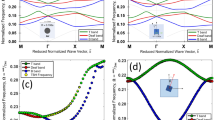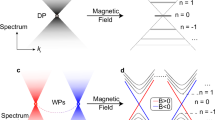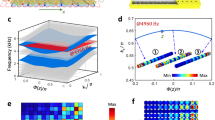Abstract
Following the discovery of the quantum Hall effect1,2 and topological insulators3,4, the topological properties of classical waves began to draw attention5,6,7,8,9,10,11,12,13,14,15,16,17,18,19,20,21. Topologically non-trivial bands characterized by non-zero Chern numbers are realized through either the breaking of time-reversal symmetry using an external magnetic field5,6,7,15,16 or dynamic modulation8,17. Owing to the absence of a Faraday-like effect, the breaking of time-reversal symmetry in an acoustic system is commonly realized with moving background fluids20,22, which drastically increases the engineering complexity. Here we show that we can realize effective inversion symmetry breaking and create an effective gauge flux in a reduced two-dimensional system by engineering interlayer couplings, achieving an acoustic analogue of the topological Haldane model2,23. We show that the synthetic gauge flux is closely related to Weyl points24,25,26 in the three-dimensional band structure and the system supports chiral edge states for fixed values of kz.
This is a preview of subscription content, access via your institution
Access options
Subscribe to this journal
Receive 12 print issues and online access
$259.00 per year
only $21.58 per issue
Buy this article
- Purchase on SpringerLink
- Instant access to full article PDF
Prices may be subject to local taxes which are calculated during checkout




Similar content being viewed by others
References
Klitzing, K. v., Dorda, G. & Pepper, M. New method for high-accuracy determination of the fine-structure constant based on quantized Hall resistance. Phys. Rev. Lett. 45, 494–497 (1980).
Haldane, F. D. M. Model for a quantum Hall effect without Landau levels: Condensed-matter realization of the “Parity Anomaly”. Phys. Rev. Lett. 61, 2015–2018 (1988).
Hasan, M. Z. & Kane, C. L. Colloquium: Topological insulators. Rev. Mod. Phys. 82, 3045–3067 (2010).
Qi, X.-L. & Zhang, S.-C. Topological insulators and superconductors. Rev. Mod. Phys. 83, 1057–1110 (2011).
Haldane, F. D. M. & Raghu, S. Possible realization of directional optical waveguides in photonic crystals with broken time-reversal symmetry. Phys. Rev. Lett. 100, 013904 (2008).
Wang, Z., Chong, Y., Joannopoulos, J. D. & Soljačić, M. Observation of unidirectional backscattering-immune topological electromagnetic states. Nature 461, 772–775 (2009).
Wang, Z., Chong, Y. D., Joannopoulos, J. D. & Soljačić, M. Reflection-free one-way edge modes in a gyromagnetic photonic crystal. Phys. Rev. Lett. 100, 013905 (2008).
Rechtsman, M. C. et al. Photonic Floquet topological insulators. Nature 496, 196–200 (2013).
Hafezi, M., Demler, E. A., Lukin, M. D. & Taylor, J. M. Robust optical delay lines with topological protection. Nature Phys. 7, 907–912 (2011).
Hafezi, M., Mittal, S., Fan, J., Migdall, A. & Taylor, J. M. Imaging topological edge states in silicon photonics. Nature Photon. 7, 1001–1005 (2013).
Khanikaev, A. B. et al. Photonic topological insulators. Nature Mater. 12, 233–239 (2013).
Chen, W.-J. et al. Experimental realization of photonic topological insulator in a uniaxial metacrystal waveguide. Nature Commun. 5, 6782 (2014).
Liang, G. Q. & Chong, Y. D. Optical resonator analog of a two-dimensional topological insulator. Phys. Rev. Lett. 110, 203904 (2013).
Lu, L., Joannopoulos, J. D. & Soljačić, M. Topological photonics. Nature Photon. 8, 821–829 (2014).
Skirlo, S. A., Lu, L. & Soljačić, M. Multimode one-way waveguides of large Chern numbers. Phys. Rev. Lett. 113, 113904 (2014).
He, W.-Y. & Chan, C. T. The emergence of Dirac points in photonic crystals with mirror symmetry. Sci. Rep. 5, 8186 (2015).
Fang, K., Yu, Z. & Fan, S. Realizing effective magnetic field for photons by controlling the phase of dynamic modulation. Nature Photon. 6, 782–787 (2012).
Prodan, E. & Prodan, C. Topological phonon modes and their role in dynamic instability of microtubules. Phys. Rev. Lett. 103, 248101 (2009).
Xiao, M. et al. Geometric phase and band inversion in periodic acoustic systems. Nature Phys. 11, 240–244 (2015).
Yang, Z. et al. Topological acoustics. Phys. Rev. Lett. 114, 114301 (2015).
Kane, C. L. & Lubensky, T. C. Topological boundary modes in isostatic lattices. Nature Phys. 10, 39–45 (2014).
Fleury, R., Sounas, D. L., Sieck, C. F., Haberman, M. R. & Alù, A. Sound isolation and giant linear nonreciprocity in a compact acoustic circulator. Science 343, 516–519 (2014).
Jotzu, G. et al. Experimental realization of the topological Haldane model with ultracold fermions. Nature 515, 237–240 (2014).
Lu, L., Fu, L., Joannopoulos, J. D. & Soljačić, M. Weyl points and line nodes in gyroid photonic crystals. Nature Photon. 7, 294–299 (2013).
Wan, X., Turner, A. M., Vishwanath, A. & Savrasov, S. Y. Topological semimetal and Fermi-arc surface states in the electronic structure of pyrochlore iridates. Phys. Rev. B 83, 205101 (2011).
Fang, Z. et al. The anomalous Hall effect and magnetic monopoles in momentum space. Science 302, 92–95 (2003).
Hofstadter, D. R. Energy levels and wave functions of Bloch electrons in rational and irrational magnetic fields. Phys. Rev. B 14, 2239–2249 (1976).
Burkov, A. A. & Balents, L. Weyl semimetal in a topological insulator multilayer. Phys. Rev. Lett. 107, 127205 (2011).
Yang, K.-Y., Lu, Y.-M. & Ran, Y. Quantum Hall effects in a Weyl semimetal: Possible application in pyrochlore iridates. Phys. Rev. B 84, 075129 (2011).
Lu, L. et al. Experimental observation of Weyl points. Science 349, 622–624 (2015).
Xu, S.-Y. et al. Discovery of a Weyl fermion semimetal and topological Fermi arcs. Science 349, 613–617 (2015).
Lv, B. Q. et al. Experimental discovery of Weyl semimetal TaAs. Phys. Rev. X 5, 031013 (2015).
Nielsen, H. B. & Ninomiya, M. The Adler–Bell–Jackiw anomaly and Weyl fermions in a crystal. Phys. Lett. B 130, 389–396 (1983).
Acknowledgements
The authors would like to thank Z. Q. Zhang and K. T. Law for discussions. This work was supported by the Hong Kong Research Grants Council (grant no. AoE/P-02/12).
Author information
Authors and Affiliations
Contributions
C.T.C. initiated the programme. M.X. and W.-J.C. contributed equally to this work. All authors contributed to the analysis and discussion of the results.
Corresponding author
Ethics declarations
Competing interests
The authors declare no competing financial interests.
Supplementary information
Supplementary information
Supplementary information (PDF 1756 kb)
Supplementary information
Supplementary information (GIF 1635 kb)
Rights and permissions
About this article
Cite this article
Xiao, M., Chen, WJ., He, WY. et al. Synthetic gauge flux and Weyl points in acoustic systems. Nature Phys 11, 920–924 (2015). https://doi.org/10.1038/nphys3458
Received:
Accepted:
Published:
Issue date:
DOI: https://doi.org/10.1038/nphys3458
This article is cited by
-
Revealing topology in metals using experimental protocols inspired by K-theory
Nature Communications (2023)
-
Real higher-order Weyl photonic crystal
Nature Communications (2023)
-
Type-II Weyl points and one-way interface transmission in a three-dimensional gyromagnetic photonic crystal
Science China Physics, Mechanics & Astronomy (2023)
-
Realization of a full hierarchical topology in hexagonal bilayer acoustic crystals
Science China Physics, Mechanics & Astronomy (2023)
-
Multi-band Acoustic Topological Insulator Based on Valley Hall Effect
Journal of Superconductivity and Novel Magnetism (2023)



